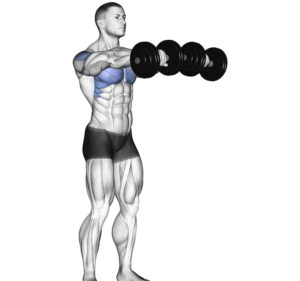The Dumbbell front raise is a fundamental exercise for strengthening and defining the shoulders, particularly the anterior deltoid. It’s a relatively simple movement that can be incorporated into various workout routines for both beginners and experienced lifters.
The dumbbell front raise is one of the most commonly utilized shoulder isolation exercises that is used for building muscle mass. In this guide, we’ve explained how to do it with tips, variations, and more.
In this guide, we’ve explained how to do it with tips, variations, and more.
Muscles Targeted
The primary muscle targeted by the dumbbell front raise is the anterior deltoid, the front portion of the shoulder muscle responsible for shoulder flexion (lifting your arm forward). Additionally, the exercise engages secondary muscles like the medial deltoid (side shoulder), upper trapezius (upper back), and biceps brachii (upper arm) to a lesser extent, helping to stabilize the movement and contribute to overall shoulder development.
Benefits of Dumbbell Front Raises
- Increased Shoulder Strength and Size: Regularly performing dumbbell front raises can lead to stronger and more defined anterior deltoids, contributing to a more sculpted upper body appearance.
- Improved Shoulder Stability: The exercise strengthens the muscles surrounding the shoulder joint, promoting better stability and potentially reducing the risk of injuries.
- Enhanced Athletic Performance: Strong shoulders play a vital role in various athletic activities like throwing, pushing, and overhead pressing. Front raises can improve performance in these movements.
- Improved Posture: Well-developed shoulders can help maintain proper posture by supporting the upper back and preventing hunching.
- Target Muscle Group: Deltoid anterior
- Type: Hypertrophy
- Mechanics: Isolation
- Equipment: Dumbbells
- Difficulty: Beginner
Muscles Worked
Deltoid anterior
Deltoid Lateral
Pectoralis Major Clavicular Head
Serratus Anterior
- Related Articles: The Top “5 Exercises To Build Insane And Crazy Shoulder Muscles”. Try Them Out ASAP
Check Out Our List Of The Best Supplements For Building Muscle, Shredding Muscle, Recovery, And Great Health, and Wellness Products! Purchase ifbnewsfeed.org‘s apparels Here: ifbnewsfeed.org

 Step-by-Step Guide to Proper Dumbbell Front Raise Form
Step-by-Step Guide to Proper Dumbbell Front Raise Form
- Grab the dumbbells: Choose dumbbells that challenge you for 10-15 repetitions while maintaining proper form. Stand with your feet shoulder-width apart and core engaged.
- Starting position: Hold the dumbbells with an overhand grip (palms facing down) at your sides, arms slightly bent at the elbows. Keep your back straight and shoulders down.
- Lift the dumbbells: Raise the dumbbells simultaneously in a controlled motion directly in front of you. Breathe out as you lift. Keep your elbows slightly bent throughout the movement, and focus on using your shoulders to raise the weights, not your arms.
- Top position: Lift the dumbbells until your arms are parallel to the floor (or slightly higher) and your palms face forward. Avoid swinging the weights or arching your back.
- Lower the dumbbells: Slowly lower the dumbbells back down to the starting position in a controlled manner. Breathe in as you lower. Maintain proper form throughout the descent.
How To Do The Dumbbell Front Raise
- While standing, hold the dumbbells by your sides using a neutral/hammer grip.
- With the elbows slightly bent or extended, raise the dumbbells up in front of you until your hands are just above shoulder height.
- Lower the dumbbells back down and repeat.
Dumbbell front raise tips
- Choose a challenging weight that you can lift without having to swing it.
- Advanced lifters are better able to utilize momentum to overload the front delts further.
- You can perform the exercise using both arms at the same time although it’s very common to do the alternating variation.
- Using a neutral grip is better for the health of the shoulders. The pronated or overhand grip is more likely to cause internal rotation of the shoulder which is not ideal.
- Learn On How “To Get Wider Broader Shoulders” With These 9 Insane Exercises
Dumbbell Front Raise Variations:
1. Barbell front raise
2. Cable front raise
3. Incline front raise
Key Points for Proper Form
- Maintain a neutral spine: Keep your back straight and core engaged throughout the movement to avoid arching or rounding your lower back.
- Focus on shoulder movement: Isolate your shoulders by minimizing bicep involvement. Don’t swing the weights to lift them.
- Controlled motion: Lift and lower the dumbbells with control. Avoid jerky movements.
- Full range of motion: Aim for a full range of motion by going all the way up to shoulder height and all the way down to the starting position with relaxed arms.
- Don’t overextend: Avoid raising the dumbbells higher than shoulder level, as this can put strain on your shoulders.

 Variations of the Dumbbell Front Raise
Variations of the Dumbbell Front Raise
- Seated dumbbell front raise: This variation can be beneficial for those with lower back problems or who want to focus more on shoulder isolation. Sit on a bench with your back straight and core engaged. Perform the front raise as described above.
- Hammer dumbbell front raise: Hold the dumbbells in a neutral grip (palms facing each other) throughout the movement. This variation can place more emphasis on the medial deltoid.
- Alternating dumbbell front raise: Raise one dumbbell at a time, then alternate with the other arm. This can help maintain core engagement throughout the exercise.
- Incline dumbbell front raise: Perform the front raise while seated on an incline bench. This can target the upper portion of the anterior deltoid more effectively.
Programming Dumbbell Front Raises into Your Workouts
- Sets and repetitions: Aim for 3-4 sets of 8-15 repetitions per set. Choose a weight that challenges you for the desired rep range while maintaining good form.
- Frequency: Include dumbbell front raises in your upper body workout routine 2-3 times per week. Allow adequate rest time for your shoulders to recover between workouts.
- Progression: As you get stronger, you can increase the weight, sets, or repetitions to continue challenging your muscles and promoting growth.
How To Incorporate The Dumbbell Front Raise Into Your Training Routine
Wrapping Up
More About Dumbbell Front Raise (Shoulder Development) Contents
- The “BEST SCIENTIFICALLY PROVEN 2 Shoulder Routines” To Get Insane And Crazy Shoulder Workout Pump
- Learn On How “To Build Massive Muscle Mass” For Your Shoulders With These Great Tips

- Hormone Replacement Therapy regimen For Men and women
- Hormone Blood Testing for Men (Bodybuilder Blood Testing)
- Shop Optimum Nutrition Energy: Anytime & Pre-Workout
For More News And Daily Updates, Follow IFBNewsfeed.Org™🇺🇸 on Facebook, Twitter, and Instagram. Comment, Like, And Share With Everyone Who May Need To Be Updated With The Most Recent Fitness/Bodybuilding/Powerlifting And CrossFit News.









